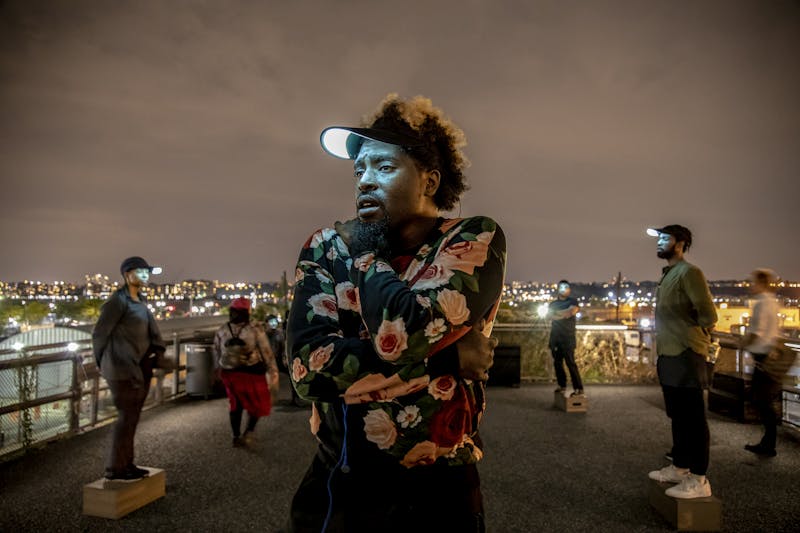There are a couple of bars from The Mile Long Opera that I can’t get out of my head. “Funny how a manicure / Changes everything,” the line goes, rising up and holding at a level note in the middle, before doing a hop step back down. Then the line is sung again, but with the word “nothing” instead of “everything.” The phrase repeats with other words replacing “manicure”—“heartbreak,” “no L Train,” “hope”—but the back and forth of “nothing” and “everything” keeps going.
Will The Mile Long Opera be everything that matters about public art—or nothing? The show officially opens on Wednesday and runs until October 7, up and down New York City’s High Line, a leafy 1.45 mile-long esplanade constructed on a former elevated railroad over Chelsea. (You can watch the opera online as well.) Its full title is The Mile Long Opera: A Biography of 7 O’clock. It’s a linear, interactive experience: You walk down the High Line, bracketed by singers from community choirs across New York. Every so often little groups surround you like a chamber ensemble.
The effect is extraordinary. It’s polyphony, but you, the listener, control what you hear. Curious about how the music melds with the music further down the park? Just keep walking. Captivated by a particular passage? Stay where you are. Dynamics in sound become dimensions in space. You’re so close to the singers that it’s awkward. Look them in the eye or look at your feet: It’s your choice.
The opera was conceived by architects from the firm Diller Scofidio + Renfro (which designed the High Line in collaboration with James Corner Field Operations and Piet Oudolf), and composed by David Lang, with libretto by the poets Anne Carson and Claudia Rankine. It is an enormous endeavor, comprising a thousand singers. The performance starts at 7 p.m. each day and is a tribute to that time of the evening. Drawn from interviews with New Yorkers, there are stories about leaving work and walking home; complaints about how the streets are clogged with trash; tender lyrics about solitude and work and the city. It is a social opera, set in a social space.
The work and the setting, however, mesh uneasily. The High Line is not New York, at least not the New York represented by those everyday stories. In 2017, Robert Hammond, the executive director of the nonprofit Friends of the High Line, admitted that its creators “failed” to provide a genuine community space to the neighborhood. Its users are mostly tourists. They’re mostly white. Can an opera seeking to channel life in New York succeed when its stage is close to being democratic, but not quite?

Controversies often flock around public artworks, particularly those which invite regular people to participate in them. The work of Tino Sehgal, for example, exists in choreographed activities performed by people who are not the artist, including members of the public. His 2010 piece “This Progress” called for a series of guides at the Guggenheim to ask museum-goers about their ideas of progress, with the museum’s famous rotunda as a backdrop. Sehgal’s work scales down art from being an object outside of history to the little moment of human beings interacting.
When audience members play a key role in a work of art—as big public works invite them to do—something is being demanded of them. The Mile Long Opera is no different. It relies completely on your participation to exist. If I could somehow render onto the page those bars that are stuck in my head, it might give you a sense of what it felt like for a single moment to stand next to a woman who was singing the lines in a tremulous voice. But you would miss the seconds before and after that moment, when I was moving in and out of earshot, in and out of the sounds of the city itself: the other sounds of 7 o’clock.
Those who see the show this week will experience different weather conditions. On my night with the Mile Long Opera, a strong wind blew. It was a hot wind on a dark night, the kind of wind that feels like it’s carrying some significant change. The air rustled the grasses, with a few large raindrops passing through it. Cicadas rasped in rhythm, as they do. Sometimes I was beside a tree containing a single cicada, and at other times every cicada on the High Line melted into a background chorus. A whistle blew at a sports game down at Chelsea Piers; a motorcycle whined a sinister Doppler effect that worked into the harmony of the performance.
The High Line can feel isolated from the city, pedestaled and artificial, but that dark, sheltered stream of foot traffic also intersects with New York itself. Where you cross 26th Street the old New Yorker neon sign is visible out of the corner of your eye. A fire escape is so emphatically “Manhattan” that it looks like it came from the stage set for Rear Window. Zaha Hadid’s new welter of condos looms on the left like a big glowing cake, Diane Von Furstenburg’s polygonal penthouse attic is to your right.

The chorus was diverse, by age, gender, race, and language (including Japanese and Spanish). Both young women and elderly men sang, “I think about coffee cups a lot.” Different voices rose to prominence, depending on where you stood. Some people looked at the ground, trying just to hear, but others stood face to face with singers and stared them down. The variation in the voices is perhaps the key joy to the music. A man with a baritone boomed the words “Not just survival.” Nearby, a weaker voice engaged in a soft recitative. Isn’t this how the city is at 7 o’clock? On the subway or the street we tune in and out, to the low and to the loud.
In the penultimate section, the chorus walk with glowing bags as if returning from an errand. We used to know each other, they mourn. Where is the intimacy that we, dwellers in the big city, have lost? This is just one New Yorker’s feeling, and yet when a whole gang of people sing it, the feeling becomes something different—a collective emotion that transcends time and subjectivity.
Soon this music will be available for everybody to hear online. Its value as a work of public art, though, comes from the memory of those who participate in it. For me, it was as much the motorcycle-whine and hot night air as it was the harmony in a minor key, fading between phrases and melodies as I floated above the west side of Manhattan. The whole project, from the variable weather to the first-person voice of the libretto, suggested that the most important thing was how I felt at that moment, one little mind moving through a river of voices. In The Mile Long Opera, there are as many operas as there are listeners, because it changes according to your position in space and your frame of mind. It exists to the extent that one is tuning in. It’s funny how art can mean nothing, depending on whether or not you’re listening; funny how an opera can change everything.

